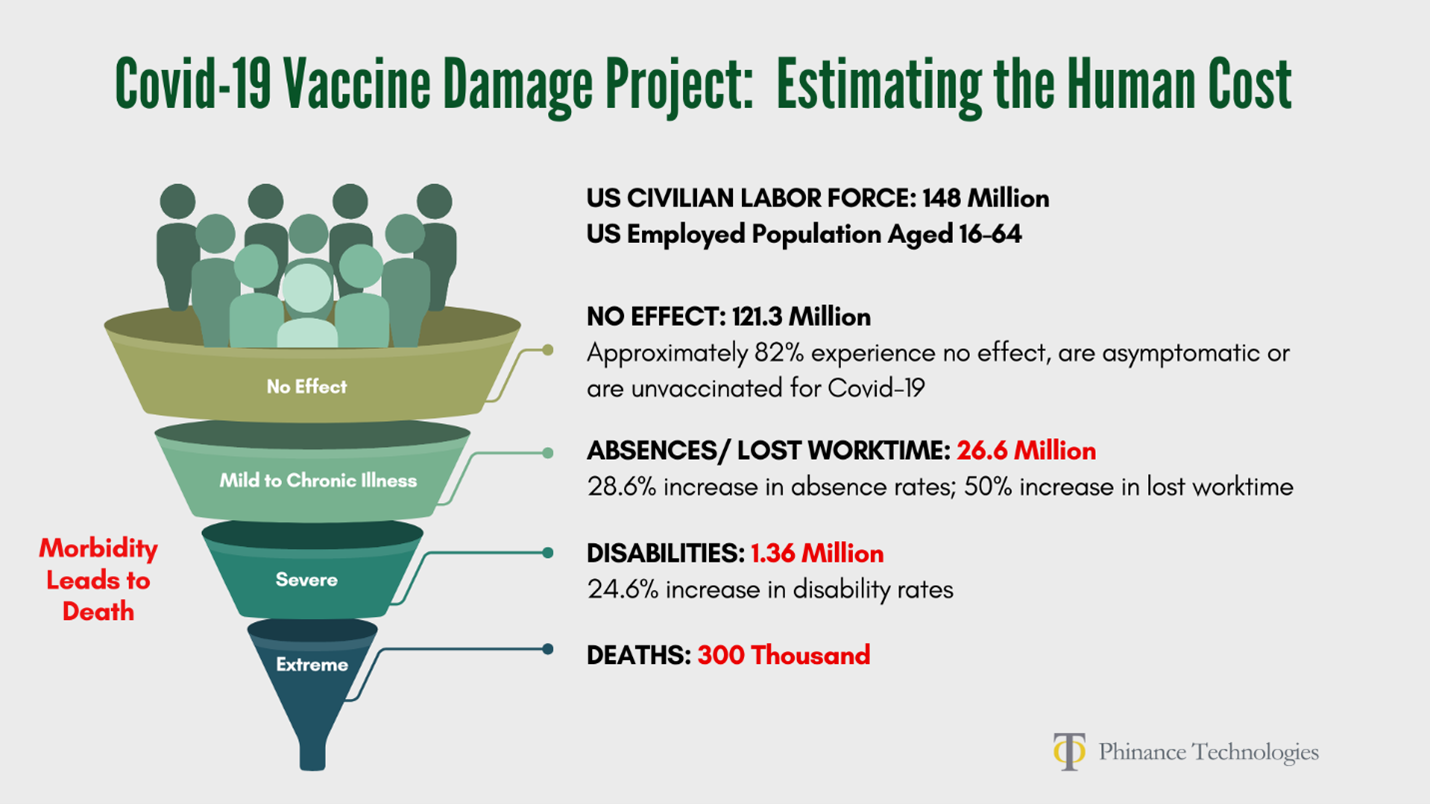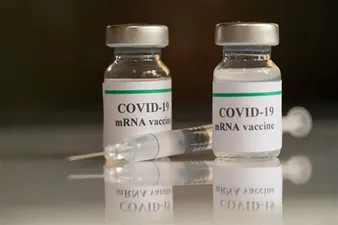Covid-19 vaccination impact
Phinance Technologies finalized the program about Covid 19 impact on individuals. V-Damage Project is a study of the direct impact from the mass Covid-19 inoculations on individuals at a population level. In particular, their look at the employed population, aged 16 to 64 in US. The impact of the inoculations was categorised into four broad groups differentiated by the severity of outcome. Of the inoculated individuals, a large group will likely experience no adverse effects, another large group will experience mild or moderate adverse effects, which could be temporary in nature or have long-term, even permanent manifestations.

Another group of individuals could experience severe outcomes leading to a disability as well as the most extreme outcome of death. Summarising, the different possible outcomes for individuals who took the inoculations are:
- No effect or asymptomatic.
- Mild to moderate outcome including a temporary or short – term, long- term, or even permanent injury;
- Severe outcome that leads to a disability;
- Extreme outcome leading to death.
The figure below illustrates the different groups of outcomes from the mass vaccinations. While these groupings characterise different levels of damage from the inoculations, they are not static and could interact with each other. For instance, there might be individuals who had no visible effects after vaccination but nonetheless could still be impacted from the inoculations and could therefore be represented in the sub-group of injured individuals. In a similar way, individuals with mild injuries from the inoculations could, over time, develop severe injuries to the extent of being disabled, or an extreme outcome such as death. The likely path of outcomes would be from injury to disability to death. We need to consider, however, that to a lesser extent there could be individuals who suffer extreme outcomes when they had previously only experienced mild injuries until then. We can relate this with the anecdotes of otherwise healthy athletes suffering heart attacks during sports competitions at an alarming rate since the 2021 inoculations.

- No effect or asymptomatic.
This group of individuals comprises those individuals who did not experience adverse events following the Covid 19inoculations. Although this group of individuals is most likely the largest, however, we cannot know for certain as to the proportion of the whole population that this group of individuals represents. We assume that these individuals are all those that are not included into the other three groups. Because the number of individuals are likely in group two (injured) represent and estimated 18% of the population (see below), group one would amount to about 82% of the population.
- Mild to moderate injury outcome.
Individuals in this group are those who experienced mild to moderate adverse effects after vaccination.These adverse events could be the early sign of an injury that is temporary, long-term, or permanent in nature. Under this definition we investigated the excess rate of related adverse events in vaccinated individuals (23.90%) compared to the placebo baseline (5.98%) in the Pfizer clinical trial (reviewed here) . This is a first-order approximation for the affected population. As for the difference relative to the placebo rate, we obtain (23.90% – 5.98% = 17.92%). The rate of adverse events in the clinical trial is corroborated by the analysis of the V-Safe database where the rate of individuals who were not able to work (but not hospitalised) after vaccination was about 29.47%. This rates includes the placebo baseline, which is unknown for the population sample of V-Safe users. They are similar to the rate of vaccine-related adverse events from the Pfizer trial. Taking all this evidence into consideration, we make the assumption that the pool of potentially vaccine-injured individuals is about 18% of the population, which is, the rate of related adverse events reported in the Pfizer clinical trial (minus the baseline rate).
These injuries will likely manifest a loss of productivity since, as these individuals are likely to have higher absentee rates and, consequently, higher lost worktime rates, than the pre-2019 baseline. In fact, we performed an analysis of absence rates and lost worktime rates in full time workers (using data provided by the BLS). We observed a large increase in absence rates starting in 2020, but accelerating in 2022. Absence rates in 2022 were about 28.6% higher than in 2019, representing a 11 standard deviation variation.
3 – Severe outcome: disabilities.
These individuals are easier to characterise accurately as they are associated with severe effects after vaccination, such as being disabled.
Using this definition, we investigated the rise in disabilities that has occurred since the start of the vaccine rollout program, in Parts 1 to 4 of our US disabilities project.
We also investigated the excess rate of Serious and Severe Adverse Events in vaccinated individuals compared to the placebo baseline in the Pfizer and Moderna clinical trials (here), and the Severe Adverse Events in the Pfizer trial. This was then compared with the rise in disabilities at the population level (Part 5 and Part 6).
Furthermore, the rate of hospitalisation with five or more days of lost work derived from the V-Safe database, corroborates at a population level our computations of time-series of Serious and Severe Adverse Events.

4 – Death – Extreme outcome.
This group of individuals died as a consequence of vaccination. We compute excess mortality estimates using our method 2C, as described in our methodology report (here), providing an estimate of the extent of the Covid-19 pandemic’s damage.
At the population level, deaths caused by Covid-19 vaccinations and other causes of death are not easily distinguished. For example, in older individuals, excess mortality could be driven substantially by Covid-19, while in younger individuals the increase in fentanyl overdoses or other causes could play a role.
Starting in the summer of 2021, however, with the introduction of mass vaccinations, the rise in natural immunity by exposure to the virus, and the emergence of milder and more contagious virus strains such as Omicron, it is difficult to argue if Covid-19 had a significant role in excess mortality. Therefore, we can use the total excess mortality in 2021 and 2022 as an estimate for vaccine-related deaths, or at least an estimated upper limit for the vaccine damage. We compute excess mortality estimates using our method 2C, as described in our methodology report (here).
The analysis of excess mortality for 2020, 2021 and 2022 can be visualised in the interactive charts (here).
Conclusions
We summarised the human cost of the Covid-19 inoculations by identifying three broad groups of people who suffered varying levels of damage. We estimated the pool of individuals within the population who belong to each of these vaccine-damaged groups, using the US population as an example.
We investigated the human cost in relatively young and healthy age groups as these are the most representative for the productive population (workforce). For absences, we estimated the injured pool of individuals by using the full time workers aged 25-54, while for disabilities we use the employed workers aged 16-64 and for excess deaths we use the population aged 25-64.
Our results are summarised below:
Group 4: The most extreme damage (death).
- Excess deaths are estimated to have occurred at an absolute rate of about 0.1% of the population aged 25-64 for 2021 and 2022 combined (upper limit).
- This represents about 23% excess mortality for 2021 and 2022, relative to the expected baseline.
- In absolute numbers, this represents about 310,000 excess deaths.
Group 3: With severe damage (disabilities).
- The rise in disabilities in the Civilian Labor Force population since the start of 2021 was about 0.93%, corresponding to a 24.6% rise.
- In absolute numbers, an estimated 1.36 million individuals aged 16-64 that are actively engaged in the labour market, became disabled.
Group 2: With mild to moderate damage (injuries).
- About 18% of the Employed Labor Force aged 16-64 is estimated to have suffered injuries due to the Covid-19 vaccine rollout program that started in 2021.
- In absolute numbers, an estimated 26.6 million individuals have been injured by the inoculations.
- This corresponded to a 28.6% rise in absence rates in 2022 relative to 2019, and a 50% rise in lost worktime rates.
https://phinancetechnologies.com/HumanityProjects/Projects.htm
In February 26, 2024 Edward Dowd, Founding partner of Phinance Technologies gave a presentation to US senator Ron Johnson. {video below}



